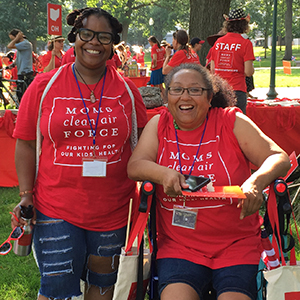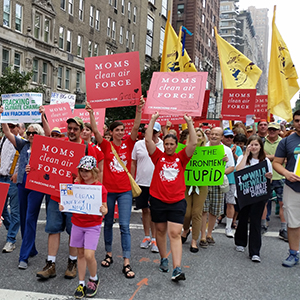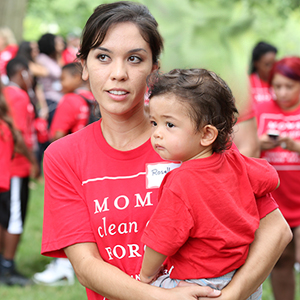This resource has been factchecked by policy experts, using the latest scientific research. Find all our sources linked below.
Air pollution and extreme heat threaten the health of everyone, but both pose outsize risks for pregnant people and babies.
Pregnancy is a time of extreme sensitivity. Children exposed to pollution and extreme heat in the womb are at risk of low birth weight, improper immune system development, lower cognitive intelligence, and gestational diabetes as well as long-term health impacts, including asthma and high blood pressure.
Climate change has drastically increased the incidence of heat waves, wildfires, and superstorms, all of which also increase air pollution. Extreme heat, for example, exacerbates ground-level ozone pollution, commonly called smog. Exposure to air pollutants such as ozone during certain periods of pregnancy has been linked to preterm birth, which can have long-term health consequences.
While air pollution and extreme heat threaten all pregnant people, the impacts are disproportionately high in Latino communities owing to their proximity to sources of pollution as well as exposure to extreme heat in living and working environments. Hispanic mothers are more likely to live in areas with high levels of air pollution compared to their white counterparts, are more impacted by wildfire smoke, and are at higher risk of stillbirths from ozone exposure. They are also at increased risk for impacts of extreme heat, including pregnancy loss as well as preterm birth and low birth weight.

Health disparities and Latina maternal health
In the U.S., there’s a large gap in maternal health concerns, including death, between Latinas and non-Hispanic whites. Latinas have the highest fertility rates in the U.S. and are more likely to experience pregnancy problems.
Vulnerabilities specific to the Latino community range from preexisting conditions, including diabetes, to lower socioeconomic status, less access to education, lack of equitable access to health care, as well as sexism and racism within health care systems. All of these can inhibit proper communication and treatment. Communication can be further hindered by language barriers as well as general medical and institutional mistrust. Over 50% of Latinas in the U.S. become pregnant at least once before age 20, so lack of trust can be compounded by age.

Air pollution and pregnancy
These air pollutants in our everyday lives can impact children in utero, and detrimental health effects can emerge many years after they’re born.
- Soot pollution, a.k.a. PM 2.5 or particle pollution, is tiny droplets or particles in the air from a variety of sources, including the burning of fossil fuels for energy and wildfires. Children exposed during pregnancy are at higher risk of elevated blood pressure as well as asthma.
- Smog, a powerful lung irritant also known as ground-level ozone, can increase preterm birth risk. It forms in the atmosphere when certain chemicals, typically from power plants and transportation, combine with heat and sunlight.
- Indoor air pollution can include volatile organic compounds (VOCs) from transportation, oil and gas operations, and typical household items like paints and pesticides. Exposure to VOCs in the womb can increase the risk of low birth weight as well as respiratory disease in childhood.
- Hazardous materials, like asbestos, radon, lead dust from paint, and mercury in flooring, can create ambient air pollution linked to adverse birth outcomes, especially in older homes.
- Wildfire smoke exposure can lead to preterm birth, and children exposed in utero are more likely to suffer respiratory infections.

Extreme heat and maternal health concerns
Heat is the leading cause of weather-related deaths in the U.S. High heat can also cause preterm birth, low birth weight, pregnancy loss, and heat-related stress in newborn babies.
Latinos are disproportionately represented in the outdoor workforce, making them at higher risk for extreme heat exposure: 78% of agricultural workers in the U.S. are Hispanic, and 34% of crop workers identify as female. Farmworkers, especially women and pregnant people, can lack knowledge of heat-related illness and symptoms.
Older housing, a scarcity of green spaces, and lack of access to air-conditioning also increase the risks of extreme heat, especially for historically marginalized pregnant people. Latinos are more likely to live in areas of the U.S. that are vulnerable to extreme heat.
What can Latina pregnant people do to protect themselves?
It’s not up to pregnant people alone to protect themselves. It’s good common sense to consult with a doctor, check local air quality on sites like AirNow.gov, and limit outdoor exercise during extreme heat and when pollution levels are unsafe for sensitive groups. But there isn’t always clear, easily accessible public information in English and Spanish available.
There’s a need to equip Latina pregnant people overburdened by air pollution and heat exposure with tools and knowledge where they live, including affordable air-conditioning units, air purifiers, air quality monitoring systems, as well as community cooling centers, shady green spaces, and “clean” rooms near busy roads and polluting facilities.

Join us
Pregnant people and children deserve to breathe clean air and remain safe before, during, and after episodes of extreme heat. Join Moms Clean Air Force and EcoMadres in advocating for equitable, family-focused climate adaptation measures and demanding strong policies that fight climate change, extreme heat, and air pollution.

A note on language
Although there is strong overlap between the terms “Latino” and “Hispanic,” they are not exactly the same, and the way that Latino and Hispanic individuals describe themselves is not universal or static. Here, the term “Hispanic” is used when citing specific research that uses this term. “Latino” is used in all other circumstances.
Learn more about Moms’ work on extreme weather.
Full list of sources.
Released: August 2024




